Out-the-front (OTF) automatic pocketknives have a mystique about them. They are members of the switchblade family, and switchblades have been the subject of controversy and legislation for ¾ of a century now. Because of the bad boy taboo they (used to) represent, their association with lawlessness (whether or not it’s true), and the fear-inducing automatic deployment feature rocketing the sharp blade straight-forward from the handle, they are perceived to be as dangerous as a cocked crossbow loaded with a bolt at the ready. They just seem inherently hazardous, like they’re about ready at any moment to launch that sprung, sharp blade deep into your leg, through your hand, or penetrate whatever point it toward.
Well, let’s settle a few misconceptions here. An OTF is a knife whose blade is under the tension of a spring, but that’s about it. In fact, a slip-joint jack knife also has a blade under back spring tension. While slip joints pivot at the bolster and are manually opened from the side rather than automatically deploying from the front, slip joint blades are still under spring tension. To be fair and honest, most OTFs are simply fast openers, not the fake news of being spring-loaded, razor-sharp bayonets that will push deeply into flesh with the greatest of ease during the opening action.
In a little test conducted in The Knife Karen Official Knife Lab, I opened the Benchmade Shootout (the subject of this article) into a sheet of cheap printer paper dangled just a 1.5” away from the front of the knife. Two things happened:
- The blade deployment mostly just pushed the paper back, but it did leave a tiny (4.50 mm / 0.178”) nick in the paper. It could hardly penetrate through the cheap, thin printer paper!
- More significantly, when that test was run, the tiny resistance from the inertia of that thin sheet of printer paper against the spring-thrusted blade caused the blade to jump off its deployment track, leaving it in a loose, disconnected state. I had to manually pull the blade all the way out to get it reconnected and working again.
I believe this is a built-in safety feature, which is a good thing. But I want to emphasize that this whole exercise demonstrates how, compared to a manual open knife, truly dangerous a modern OTF knife really is. It really ain’t.
TL;DR
Benchmade, founded in 1979, released their first out-the-front automatic knife, the Infidel, in 2000. They were not the first modern, US knifemaker to do so (Microtech released the HALO in 1994), but they’ve had a solid quarter century of experience now with designing and building this type of knife. They have refined their designs and engineering, as well as improved their products by seeking out the latest and greatest varieties of modern blade and handle materials over the years (unlike the poor old Opinel). As such, their OTFs work as expected. With 8 models on the market today (spanning from lowest end to highest), we can buy any of these: Om 4850, Shootout 5370, Mini Claymore 3375, Claymore 3370, Phaeton 4600, Mini Infidel 3350, Autocrat 3400, and Infidel 3300. Benchmade has a good selection of products at various levels of quality and prices. The myriad of handle materials represented in their OTF inventory include (again, from low-end to high-end): Zytel, Grivory (both of these first 2 are identical compositional forms of fiberglass reinforced nylon, aka FRN, but manufactured by different companies), G10, and aluminum, while blade steels used include CPM D2, CPM S30V and CPM Cru-Wear (who loves Crucible? Benchmade loves Crucible! ❤️).
The knife being reviewed here is the double-action, automatic Shootout OTF equipped with a thin, CPM Cru-Wear blade and a dark purple Grivory handle. The Shootout is the second lowest-end model in the Benchmade OTF line-up. There’s a lot to talk about, so let’s press on.
Pros
- Out-of-the-box blade was very sharp
- Slide button action is good
- Purple color is great, especially on the polished pocket clip
- Handle is very grippy, if not actually abrasive
Cons
- Uneven bevel grinds per side
- Uneven swedge sizes per side
- Blade hardness claims don’t make sense
- Grivory always feels cheap
- There are noticeable handle seam fitment issues
- Over-priced compared to other American-made OTF competition
Tech Specs
Brand | Benchmade |
Website | |
Manufacturer | Benchmade |
Origin | Oregon City, OR, USA |
Model Reviewed | Black Class Shootout 5370GY-06 (aka Benchmade Shootout Seasonal Dark Purple) |
Designer/Design | Justin Koch |
Model Launch Year | 2024 |
Style | OTF knife |
Lock Type | Thumb slide button |
Opening Type | Automatic OTF |
Opening Mechanism(s) | Double-action spine-based, fire anodized purple thumb slide button |
Length Closed | 124.96 mm (4.92") |
Length Opened | 212.07 mm (8.35") |
Weight | 81.78 g (2.89 oz.) |
Weight-to-Blade-Length Ratio | 0.93 |
Original Packaging | Heavy, rigid, Black Class paperboard, full telescope box with a dense, black, medium-soft, large closed-cell foam lining pressed into the lower. Knife is enclosed in a black, satin drawstring bag & box includes a rectangular-folded Use & Care sheet. |
MSRP & Retail Price | MSRP: $375 (Discontinued) |
Edge | Plain |
Shape | Tanto |
Material | CPM Cru-Wear |
Claimed Hardness HRc | 63-65 |
Blade Length | 88.14 mm (3.47") |
Cutting Edge Length | 86.86 mm (3.42") |
Primary Bevel Angle | 3° |
Original Edge Angle | Show side: 24° |
Height | 19.82 mm (0.78") |
Thickness | 1.75 mm (0.07") |
Main Bevel Edge Thickness | 0.50 mm (0.020") |
Finish | Gray PVD |
Features | The edge bevels are uneven. The show side is steeper compared to the clip side. Additionally, the second grind of the front Tanto edge is a fair bit shallower than the main edge bevel, with show side at 29° and clip side at 27°. Additionally, the swedge length is not symmetrical, being a full 3 mm longer on the show side. |
Grind | Full flat |
Swedge | Show side: 53.22 mm (2.095") |
Fuller | None |
Jimping | No jimping on blade; handle has jimping on the top & bottom of the back (10 cuts), & bottom front has (8 cuts). OTF slide button has 4-cut jimping on front side, while backside has 7 cuts. |
Blade Markings | Show side: Lightly printed company logo at top of bevel near ricasso & below flat |
Sharpening Choil | 6.32 mm (0.249") |
Materials | Grivory (a glass fiber reinforced polyamide [nylon] compound) |
Color | Dark Purple |
Scale Texture | At the top of the scale underneath the slide button is a moderately fine, grippy patch of texture with the feel of coarse sandpaper. Behind that is a classic sunburst Guilloche pattern spreading down the handle, all of which are located in a bordered section that would look like an inlay). |
Handle/Scale Features | Being made of what amounts to a more resilient polymer, the handle has softened (chamfered) edges, grippy texture, modestly contoured, and a very cheap appearance. |
Handle Length | 124.96 mm (4.92") |
Blade-to-Handle Ratio | 0.71 |
Closed Handle Height | 29.92 mm (1.18") |
Handle Thickness | 12.65 mm (0.498") |
Pocket Clip | Stamped, deep-carry style |
Clip Material | Steel |
Clip Color & Finish | Polished purple PVD |
Clip Placement | Ambidextrous, Tip-Down |
Clip Length | 58.27 mm (2.29") |
Clip Length-to-Handle % | 46.6% |
Clip Features | Classic Benchmade surface-mounted with spoon bill and butterfly logo stamp |
Fasteners | 4 black-coated T6 screw heads on clip side, and 4 rounded, slightly curved Chicago binding post screws on the show side. |
The Story of Switchblade Knives
So what is a switchblade, you ask? Excellent timing, as I was going to answer this anyway! Generically speaking, a switchblade knife is a pocketknife whose blade automatically opens when the spring action pressure is unlocked and the opened blade locks into place. The blade may open from the side blade channel, or it may thrust forward out of the front of the handle. Switchblades are also known as:
- Switch knife
- Automatic knife
- Pushbutton knife
- Ejector knife
- Flick knife
- Flick blade
- Spring knife
Deployment of the blade is typically activated by the press of, or a pushing slide against, a release button.
The OTF knife, a subset of the switchblade category of knives, is a pocketknife whose blade, at the push or slide of the release button, automatically projects (and retracts, if it’s double action) through a hole in the front end of the handle.
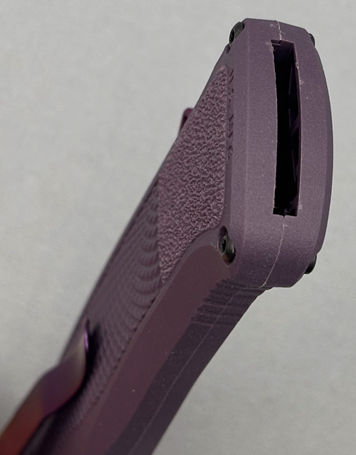
While all OTF knives are switchblades, not all switchblades are OTFs. The OTF knife is also known as:
- Out-the-front knife
- Sliding knife
- Telescoping knife
- Angel blade
- Gravity knife (yes, gravity knives are classified as switchblades! More on that in a moment)
History of Switchblades
The spring-operated switchblade knife has a surprisingly long history, going much further back than most people realize. It’s believed that the switchblade first appeared in Europe in the early to mid-1800s. (Did you catch that? Not 1900s, but 1800s!) One of the oldest known surviving examples of a switchblade is a lock back, spring-operated knife from Sheffield, England that has date marks indicating it was made in 1840!
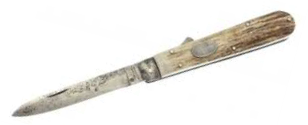
Only 11 years later, in 1851, the Crystal Palace Exhibition in London, a major world trade exhibition, spurred the development of numerous new switchblade knives with improvements in their designs. Back in those days, such precisely designed, hand-made knives were high-quality tools. They were expensive to make and even more expensive to buy. As such, switchblades were largely relegated to the domain of the wealthy class. But then the second industrial revolution, during the latter half of the 19th century, introduced factory mass production, and one of the side benefits was that all knives (and many other items) eventually became more affordable.
In 1892, George Schrade (yes, that Schrade, sort of) patented several new automatic knives, and then founded the New York Press Button Knife Company, which produced (take a guess…) push button switchblades. A decade later, Schrade sold that company and, just a year later, he and his brothers formed a new automatic knife company, Schrade Cutlery Co. They continued to improve Schrade’s original button design, including the addition of a safety switch, which eventually became the Schrade Presto knife.
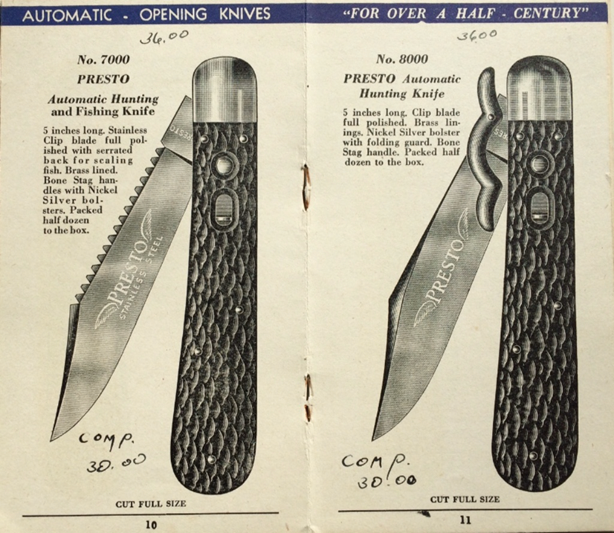
He wasn’t alone, however. Many other companies developed and sold automatic knives, many unknown today, but a few, still-popular knifemaking company brands, such as Colonial (now CCI), Camillus Cutlery, Union Cutlery (which became KA-BAR), Imperial, and several others, also took up the trade.

Even the old brand, W.R. Case & Sons Cutlery, that American stalwart of the classic slip joint knife, used to be a maker of switchblades!

In the early 20th century, most US-made switchblade knives were mostly utilitarian in design, either basic jack knife designs (for men) or pen knife designs (marketed to women so we would not break our nails). These were just simple, working knives that happened to be spring-operated. While the public largely preferred to buy manually opened knives, which by their simplicity sold at a lower price, spring-operated knives were still both popular and quite common.
During WWII, the US Military distributed the Schrade model MC1 pushbutton switchblade to paratroopers in case they needed to quickly free themselves when their parachute lines got caught in obstacles like trees, hedgerows, etc. At that moment of crisis, no one wants to try to find the bloody nail nick to open their pocketknife, especially if one shoulder, arm, or hand has been injured!
After the end of World War II, American veterans of the Italian campaign brought home examples of fine Italian Stiletto switchblades. Such beautiful knives soon became popular in the US and retailers began importing stilettos in large numbers. While many crappy replicas were imported, the genuine, good quality Italian-made knives, such as those made by Frank Beltrame and Angelo Campolin, outfitted with narrow, dagger-like, bayonet-style blades hosting a single sharpened edge (the opposite, top side of the closed knife was a false edge), a slender handle, dual bolsters, and two crossbar tabs on the front bolster that reminded people of Medieval knives (or at least what they thought Medieval knives would have looked like).

The switchblade troubles began in the next decade. An overwrought article from 1950, published in Women’s Home Companion, a popular national magazine, titled, “The Toy That Kills”, was a hit piece (ah, see what I did there?) on the switchblade knife, calling it a “menace”, and asserting associations between switchblades and criminal activity. Subsequent newspaper articles on the switchblade pushed the associations even further, connecting switchblades to Black and Puerto Rican kids and switchblade-based, violent criminal gang activity. These histrionic stories were intended to frighten the pearl-clutching majority about minority, urban violence. As a result, there began, as early as 1954, faltering legislative attempts to ban the sales and distribution of switchblades, but one more factor was needed to push the anti-switchblade knife campaign across the ban finish line. What was it?
Blame the motion picture and Broadway theater industries for this. In the mid-to-late 1950s, there was a rash of movies in which leather-jacketed, pomade-laden, slicked-back pompadour-donning, rolled-cuff blue jeans and engineer boot-wearing villains (unlike the automatic AR rifle-wielding, mega-Chads of today), were dangerously armed with knives, and more specifically, those nasty, evil, gang-sanctioned switchblades. Films such as Rebel Without A Cause (1955), Blackboard Jungle (1955), Crime In the Streets (1956), 12 Angry Men (1957), and High School Confidential (1958) were scary, switchblade-filled flicks. But even more so, the 1957 Broadway theatre production of West Side Story (not the film, as it wasn’t released until 1961) got people’s undershorts in a big, nasty-tight twist.
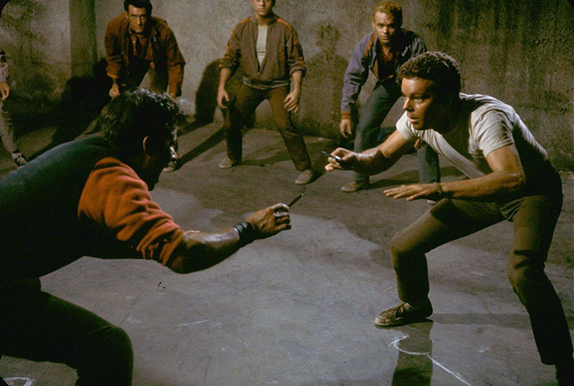
Frankly, the constant, synchronized finger-snapping of the Jets gang scared me even more than the ballet-based, modern street dancing of the Sharks (you know, as all members of gangs do).
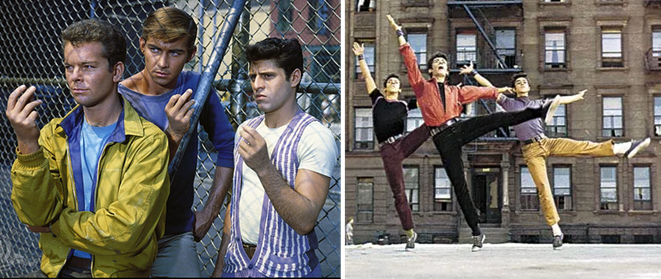
And don’t you know that when people get their undies in a twist, that’s when Congress sees an opportunity to score “points” with the fearful masses by banning something, regardless of whether that ban materially affects anything or benefits anyone.
So, on August 12, 1958, Congress passed the Federal Switchblade Act, which placed restrictions on the importation, transportation, distribution, shipping via US mail, and sales of switchblade knives. This affected all forms of automatic opening knives when activated by a device on the handle, but they added non-sprung, gravity knives for good measure. Violations of this law were a federal felony with penalties as high as a $2,000 fine and up to 5 years in federal prison! Ouch!
The FSA did include a few exceptions, of course, such as excluding the Armed Forces and government officials from the law. However, some states, not to be outdone by the obvious wisdom of the folks in Washington, DC, added even stricter laws that, in some jurisdictions, went rogue and banned even simple possession of a switchblade. That’s just ridiculous.
Congress later on, in 2009, added an amendment via a larger Federal Appropriations Bill, that allowed one-armed individuals living in a U.S. territory, Indian reservation or special maritime jurisdiction to carry a notorious switchblade knife, as long as the blade itself was no more than 3” long. It also tightened up the federal definition of a switchblade to exclude knives “with a bias toward closure” but exempted both slip joint and assisted-opening knives, such as knives like the beautiful but horribly overpriced Benchmade 585 Mini Barrage Gold Class AXIS-Assist Knife Purple Haze FC.

However, once again, some states went rogue and began completely defying the restrictions of the FSA law and removed most, if not all, limitations on automatic knives within their state boundaries. This defiance of the Federal government’s Constitutionally-based Supremacy Clause has never been challenged in court, so more and more states began following suit with the relaxation of switchblade restrictions. It’s very much like the new state-based terminations of personal use restrictions of cannabis when the federal government has not dropped its restrictions. Oh, so much fun! (I’m talking about the Supremacy Clause conflicts between the Feds and the several states, of course.)
Today much of the US public can go online to buy an OTS or an OTF switchblade, even gravity knives (which should never have been included in the first place) and have it delivered to their home, then pocket it and go about their daily business outside of the home. Not everyone shares that freedom, though. Some states have never rescinded any of their initial restrictions on switchblades, but groups like Knife Rights are working state-by-state to end the tyranny (oh, the humanity!) on our fun, little hobby of collecting pocketknives.
Introducing the Benchmade Shootout
The automatic Benchmade Shootout was originally released in the fall of 2022. It has been a popular knife for Benchmade, so they have continued to develop this product. In mid-October of 2024, Benchmade released what it deemed its seasonal release of the Shootout, outfitted in a Dark Purple Grivory handle. People loved the color, but as usual, most folks do not like the insubstantial feel of Grivory handles. Grivory is not popular with OTF thicker, mechanically-encasing handles like the Shootout, but on regular pocket folding knives, where Grivory scales are not supported with full-length steel liners, these handle scales unfortunately flex quite a bit, which generates a lot of user complaints online. That said, Benchmade knives with Grivory handles continue to sell, so I suppose it’s possible the complainers might be in the minority. But feel free to count me among them. That’s because I am a titanium fangirl. Hmmm, beefcake strong!
Details and Specs
There’s plenty to talk about with this Benchmade OTF switchblade. Please scroll down and see more!
Blade
Benchmade chose to use the CPM Cru-Wear, an American-made, particle metallurgy steel invented in 2011. The most notable feature of Cru-Wear is its relative balance of all 3 properties (at least before the advent of CPM MagnaCut). The most prominent property is its very high rating for resistance to chipping, cracking and fracture (aka toughness: 8). It’s more middle of the road in its ratings for resistance to abrasion and wear (aka edge retention: 5) and resistance to oxidation (aka corrosion resistance: 5.5), but it’s the emphasized toughness of Cru-Wear, along with its relatively moderate cost, makes this a reasonable choice for blade steel. I’ll talk more about the blade materials in a moment.
Blade Details
The Cru-Wear blade of the Benchmade Shootout comes with an applied a gray Physical Vapor Deposition (PVD) coating, which will help keep rust at bay (given the middling corrosion resistance rating). The blade face has 3 grinds: 1. a long, slender, forward swedge, 2. the huge flat primary bevel, and 3. a very narrow flat along the spine that, due to the PVD, is quite concealed. But a careful look reveals a flat that emerges from the ricasso and extends down blade until it runs into the swedge cut. The grind line between the primary bevel and the swedge is crisp and clean, but the grind between the flat and the primary bevel is so muted that the flat all but disappears without close inspection.

The Shootout blade shape is ground in the Japanese Tanto style. The key difference between the 2 styles is that the Japanese (the one that came first, if that wasn’t clear!) blade has 1 primary bevel grind that has a small break in the forward belly that changes the ascending angle toward the tip rather than a smooth belly curve like a typical drop point, whereas the American tanto style, popularized by Cold Steel, uses a compound grind with a pronounced angle break and a change in the bevel grind angle.
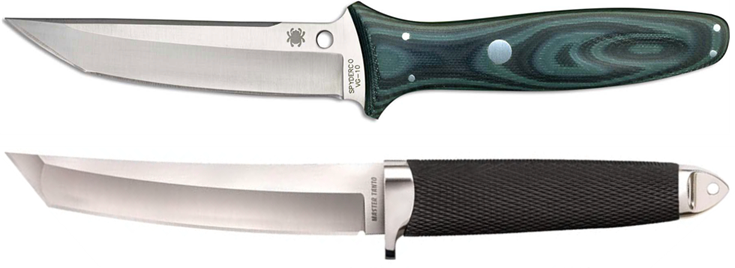
The blade spine is flat, not crowned, but unlike the wickedly sharp spine edges on Spyderco knives, Benchmade has ever so slightly knocked down those spine edges, providing a huge ergonomic benefit to the users of the Shootout. Thanks, guys! And speaking of the spine, there is no blade jimping on the Shootout, but given the thin blade and the general nature of how OTK knives are typically held and used (meaning a minimal use for very fine, precise knife cutting), I don’t consider this omission to be of any consequence.
There is a small sharpening choil at the heel of the blade that will help those who like to sharpen knives keep their Shootout honed to a razor’s edge. However, the choil is not so much curved as it is angled. This means there is more blade material immediately after the blade edge, and this will affect how easily the heel of the blade will be sharpened. And by the way, the out-of-the-box blade edge on the Shootout is very sharp.
The blade markings are minimal. On the show side, Benchmade applied a lightly printed butterfly logo at the top of primary bevel near the ricasso, below the narrow flat. The clip side presents in similarly light print the name of the steel, CPM CRUWEAR (curiously without the hyphen in Cru-Wear, which is the official way Crucible writes the name of their product), at the same location as the logo on the other side.
I do have some bad news about the quality of the blade grind, however. The edge bevel angles are not even. They’re not even close to even. Using a laser goniometer, I measured the show side edge angle to be 24°, but the clip side angle came in at 20°.
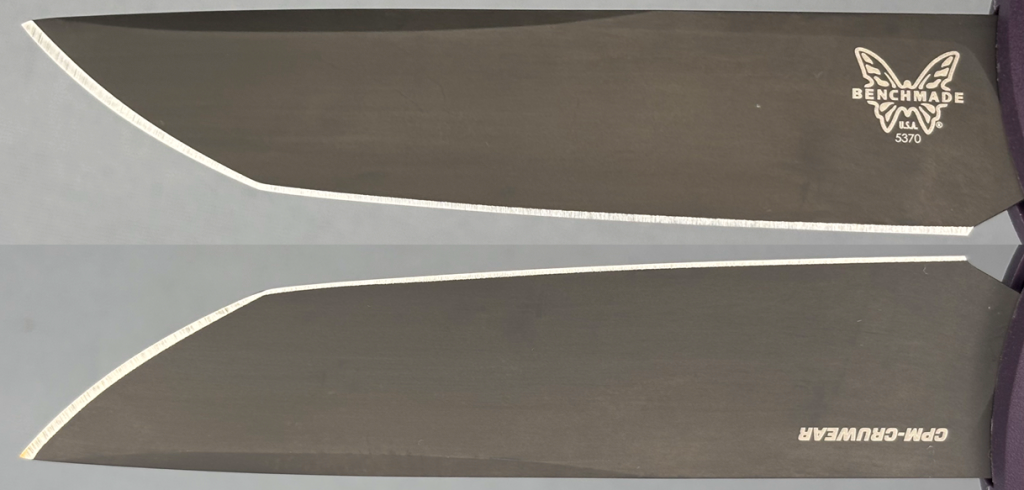
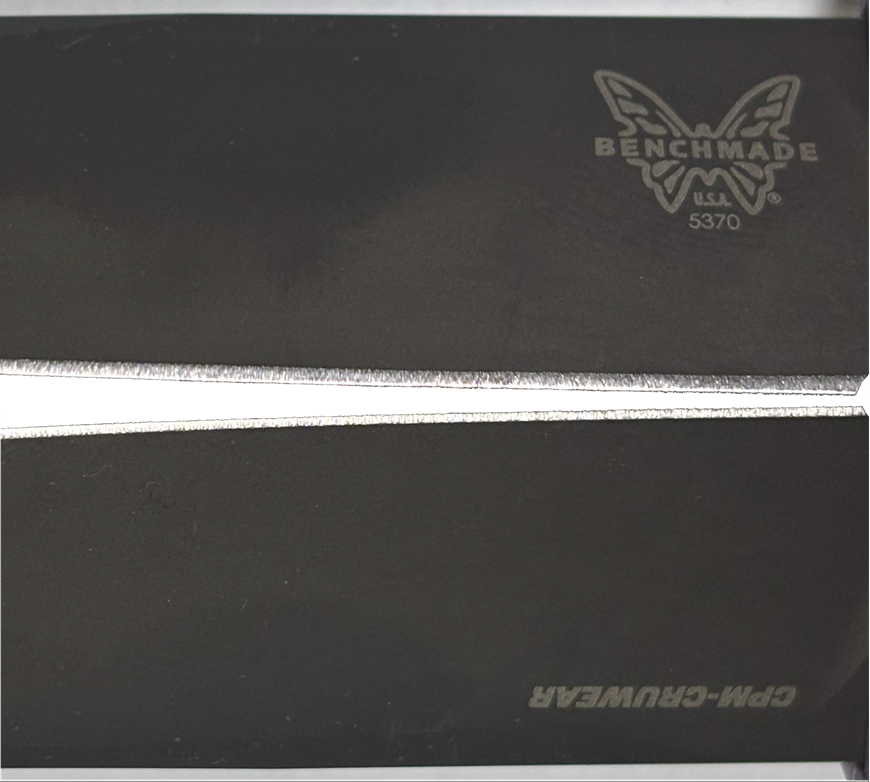
In addition, the second grinds for the forward tanto edge bevels are not the same as the main edge bevels – on either side. However, I know some knifemakers intentionally do this as a design element, although I suspect this is not the case here, but I have no way to be sure.
However, I do know that in addition to the uneven edge bevel angles, the swedge lengths are clearly different on each side of the knife, and the differences there are not a design element. It’s sloppy milling. Using my digital calipers, I measured the show side swedge length to be 53.22 mm / 2.095″, whereas the clip side swedge length came in at 50.21 mm / 1.977″.

Are these differences huge? Not really. Will these differences affect performance? Likely not. So why bring them up? Because Benchmade used to have a reputation for being a high quality, precision knife manufacturer, and given their prices being as high as they are (the Benchmade mark-up premium is colloquially known as the Butterfly Tax), they are charging for the quality of their past, not what they are offering today, and this is a true disappointment. So many other knifemakers pay attention to details such as symmetrical blade grinds. This work is an indication of quality, precision machining. For Benchmade to falter like this (these inconsistencies are obviously visible with the naked eye; you don’t need magnification to see them) is a dramatic example of the diminishment of the brand as a quality manufacturer. I am very disappointed.
CPM Cru-Wear TECHE
When I can get the ratings data for the knife steels I review (I primarily gather the data from the authoritative KnifeSteelNerds.com as available), I include it here in a section I call TECHE. What does that mean? Well, just look below.
Note that all but Hardness Range are based on a scale from 0-10; Hardness is based on the Hardness Rockwell C scale, which technically is between 20 and 68.

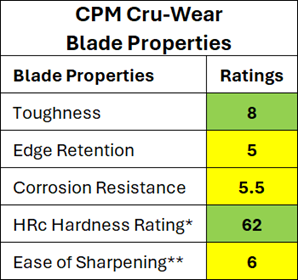
* HRc Hardness Rating data was gathered from Knife Steel Nerds. However, Benchmade claims a hardness of 63-65 HRc.
** Ease of Sharpening data is not a rating produced on KSN.
I am a fan of CPM Cru-Wear, and I find it a reasonable choice for a thin-bladed, budget-oriented OTF knife. As mentioned earlier, of the 3 principal characteristics of blade steel (toughness, edge retention, and corrosion resistance), the most prominent property in Cru-Wear is toughness. A very thin, slicey blade like the one on the Shootout is a feature that also makes it inherently fragile. This is even more pronounced on a system like the OTF, a system that inflicts significant stresses on the blade during the fast deployment and retraction (and for that matter, the looseness of the blade being used after deployment). A steel with significant toughness will better withstand all these stresses and will hold up to daily use for much longer.
I am not a metallurgist (nor have I ever tried creating industrial diamonds at home so I could have an endless supply of industrial micro-diamonds for use on my strops. I’ve never tried doing that). However, I wonder what a blade steel that’s reasonably balanced in its 3 properties, but rather than emphasizing toughness, instead emphasizes edge retention, would be like. Of course, there’s no need to worry about corrosion resistance, as Benchmade already applies a PVD coating to the blade. To me, an OTF should always be sharp. Given that, what if there was an OTF blade made of something like CPM 10V? Check this out.
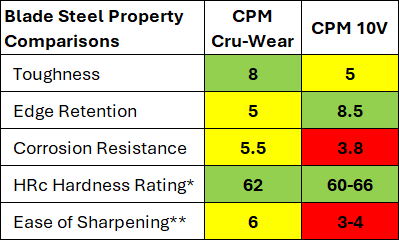
As you can see, 10V does have good toughness, which will keep the knife blade from chipping or fracturing (if you somehow manage to break an OTF’s blade, you are not using your OTF knife for the tasks in which it was designed). Think a toughness rating of 5 is inadequate for an OTF? Well, buckle up, Buttercup. I looked at BladeHQ and did an analysis of the blade steels used in the OTFs they sell. I found 27 blade steels used in OTFs, and despite the 10V toughness rating of 5, only 8 of the 27 OTF knife steels sold had a higher rating than 5.0. But the most interesting part of 10V is that it has an 8.5 edge retention rating!
Now truth be told, none of those were 10V! However, Böhler K390, a steel that is very similar to the proportions of compositional elementals used and the high edge retention ratings of 10V, was there. The drawback of steels like 10V and K390 is that they’re harder to sharpen. But there’s a good reason for this. Edge retention is synonymous with resistance to abrasion and wear. If a steel holds its edge far longer, it’ll naturally take more work to resharpen it! The excellent edge retention of 10V is due to the high amount of vanadium contained in the steel (9.5% vs just 2.4% in Cru-Wear). The high level of vanadium serves to create vanadium carbides, the hardest carbides available in blade steels, which serve to keep the blade edge sharper for a long time. Of course, this means that such steels are naturally more difficult to mill and grind, and thus more expensive for the manufacturer to use. That’s likely the reason you don’t see those steels used. Microtech used to sell the UTX-70 Warhound OTF in K390, and it was an even thinner blade than the Benchmade Shootout. It was even less expensive at $336, but the blade was a miniscule 2.4”. Hey, at least it was tried!
I’m guessing the vast majority of knife owners either do not enjoy sharpening their knives or simply don’t have either the tools or the knowhow to do it. It would be interesting to find out if a decently tough blade that stays sharp significantly longer would be a popular knife among those non-sharpener users, knowing it could be used and enjoyed for a much longer time! And if you are a blade sharpening aficionado (like me!), there’s no reason to fret. A good diamond or CDB sharpening stone would easily tame that abrasion-resistant 10V steel and give you a new, very sharp blade edge in no time. After all, you’re not dealing with CPM Rex 121 or Tungsten Carbide. The fact that 10V wouldn’t need to be sharpened nearly as often makes using such a steel and interesting idea.
But, so much for the daydream…
Blade Dimensions
We have numbers! The blade length of the Benchmade Shootout is 88.14 mm / 3.47″ with a cutting edge length of 86.86 mm / 3.42″. The blade height came in at 19.82 mm / 0.78″, its thickness at the spine is 1.75 mm (0.07″), and the edge bevel thickness was measured at 0.50 mm / 0.020″. The blade does come with a sharpening choil, the length of which I measured to be 6.32 mm / 0.249″.
The primary bevel angle came in at 3°. Unfortunately, as mentioned above, the edge bevels are visibly uneven. The factory sharpening job wasn’t what we expect from a new Benchmade. After multiple passes of taking careful measurements, I got 24° on the show side and 20° on the clip side. That’s a pretty large variance. When you can see it so clearly with your naked eye with the knife in your hand, there’s a problem. For what it’s worth, I measured the tanto end of the edge angle as well, as this was also non-symmetrical. The measurements were show side at 29° and clip side at 27°. I do know that some knife manufacturers do intentionally sharpen the tanto edge to have a different blade edge angle than the main edge angle specifically as a blade design element, so I’m letting this detail slide, but at least the edge angles should be symmetrically ground. For the price paid for this knife, a customer has a right to expect better edges than what you expect to find on Ozark Trail blades.
In addition to the blade edge angle, the swedge lengths don’t match, being longer and deeper down the blade on the show side. I measured this to be 53.22 mm / 2.095″ on the show side, and 50.21 mm / 1.977″ on the clip side. These blade work errors, taken together, are a disappointing result for a Benchmade knife.
HRc Rating
Benchmade claims their CPM Cru-Wear blade has a Rockwell hardness rating of 64 +/- 1 point. I am now without a way to independently test steel hardness levels, so we’re left to ponder their claim. It’s interesting to note that Larrin Thomas of KnifeSteelNerds evaluated CPM Cru-Wear in a toughness test at specific hardness levels. He specifically identified Z-Wear steel to be basically identical to CPM Cru-Wear, and his testing of Z-Wear revealed that it was toughest, 22 ft-lbs, when hardened to HRc 61.8. But as the steel was hardened to higher levels, its toughness descended in a straight line down. His testing included revealing the toughness to be 12.3 ft-lbs when the steel was hardened to HRc 64. YouTube knife blade hardness tester, LuvThemKnives, has professionally tested 11 Cru-Wear knives, all from Spyderco, and the average hardness of all 11 blades came in at 62.24 HRc, with none higher than 63.7 HRc.
Did Benchmade really harden their Shootout blade to 64 (or higher) when Spyderco never makes their blades that hard? And if Benchmade did, they likely cut their blade’s toughness almost in half! Pardon me for being suspicious of their hardness claim.
Opening Mechanisms
It’s an OTF knife, so there’s only 1 deployment method: the spine slide button. And since the Shootout is a double-action OTF knife, the same button is used to both deploy and retract the blade. The slide button has a medium amount of resistance to press through, which is comfortable and confidence inspiring. The button’s not too thin like OTFs from other companies, which is great. The jimping on the slide button is coarse, but the edges of the cuts are nicely chamfered, so the button is very nice to use.
If you have never used an OTF, the slide button is held in place by a spring. Well, in a double-action OTF, it’s 2 springs, but 1 for each direction of slide. As you push the slide button forward to deploy the blade, the spring resistance grows stronger and stronger. Interestingly, the slide button, before being pushed forward, has an opening travel path of 14.95 mm / 0.5885”. However, the blade won’t deploy until you push the button farther than 13.34 mm / 0.5255”, leaving just a short 1.61 mm / 0.0635” in the travel path. If you push it very slowly, you’ll really feel the strength of that spring.
But how about retracting the blade? Well, it’s not the same thing. I measured the return travel path as 14.86 mm / 0.5855” (it’s odd that it doesn’t exactly match, but the cheap, plastic handle is not perfectly finished, which explains the slightly rough (0.09 mm / 0.0035”) difference between the travel paths. But when you’re pulling that spring-tensioned slide button back down the track, the blade moves when you’ve pulled it past 11.07 mm / 0.436”, leaving 3.79 mm / 0.149” to go in the travel path. The deployment and retraction actions are triggered at slightly different lengths down the track. And remember how I said it was pretty hard to push against the opening spring when pushing slowly? It’s even harder when pulling! Of course, that’s due to the biomechanics of your hand and how different muscles are at work, but that’s why it is hard! Of course, a fast push and pull are easy enough to do, and it feels solid.


Locking Mechanism
There’s no locking mechanism on OTFs like there is on folding knives. The knife simply locks in place when deployed and again when retracted. However, we can talk about blade movement once it’s opened.
Benchmade, like most other OTF knifemakers, deal with the reality that OTF knife blades wiggle. There’s movement up-and-down, left-and-right, and pushing and pulling on the blade. None of it is dramatic, and none of this is typically a cause for concern. It’s basically the normal function for OTFs. Most OTFs.
Way back in 2016, a small knifemaker, a father and son team, Grant and Gavin Hawk of Hawk Knife Designs, invented the first zero blade play OTF switchblade, the Deadlock. It was apparently a jewel of a knife (I’ve never held one!), a masterpiece of engineering and design. But such a product, which took years of product development, was, well, a tad spendy. I see that BladeHQ lists 28 various models of the Hawk Custom Deadlock knife, every one of them sold out, and depending on the model, it could have been yours for the tidy sum of between $2,800 and $3,500 (not sure if shipping was free or not). Did Benchmade invest that much effort in their OTF knife designs? Oh, for goodness’ sake, NO! So like almost everyone else who sells OTFs, the Benchmade OTF just wiggles along.

However, don’t think those of us with a real-world budget are perpetually stuck with wiggly OTFs. Just recently, famed American OTF knifemaker Microtech released their Ultratech ZBP (Zero Blade Play) line of OTFs. Apparently, they are the real deal. And they cost just about 11% of the Hawk Knife Designs Deadlock OTFs. Coolio!

Knife Body & Scales
The handle of the Benchmade Shootout is encased in Grivory. Let’s talk about Grivory. Technically it’s a fiberglass reinforced nylon (FRN), a high-temperature resistant, semi-crystalline thermoplastic construction material based on polyphthalamide (PPA). Sounds good, right? But in practicality, the look and feel of Grivory is akin to a cheap plastic shell. It feels like a low-quality product. Metal Complex described the Grivory handle of the Shootout as feeling like a toy (when most certainly it is not, especially with the Butterfly tax!).
Let’s talk about some good things with the Shootout handle. The dark purple color is wonderful. The texture is very grippy, especially the first 25% where your thumb rests on the handle. That section is as grippy as coarse sandpaper (whether or not that is good is your call). The rest of the handle texture is made in the style of a classic sunburst Guilloche pattern spreading down the handle, enclosed in a bordered section that looks like it should contain an inlay — had there been one.

Once again, Benchmade ensured that the last 3 remaining lanyard users in the world, Jordan, Kent, and Owen, will be pleased as punch that there is a lanyard loop at the back of the handle.
There is one complaint I have with the Grivory handle (aside from the fact that it’s a Grivory handle). Benchmade did not do the job needed to ensure this product’s handle has good fit and finish. A quick look reveals the shoddy, substandard fitting in this finished (unfinished) knife. There is no way that a knife from a company with the resources of Benchmade and their significant Butterfly tax revenues should have so many seam gaps like this. A prototype? OK, sure. But a finished product? Hella, no! And if Benchmade came back and said that the thinness of the Grivory material makes it difficult to get good seam fitment, then it’s still on Benchmade for using a handle material that can’t be reliably made into a professionally-made, expensive knife. This is crap.
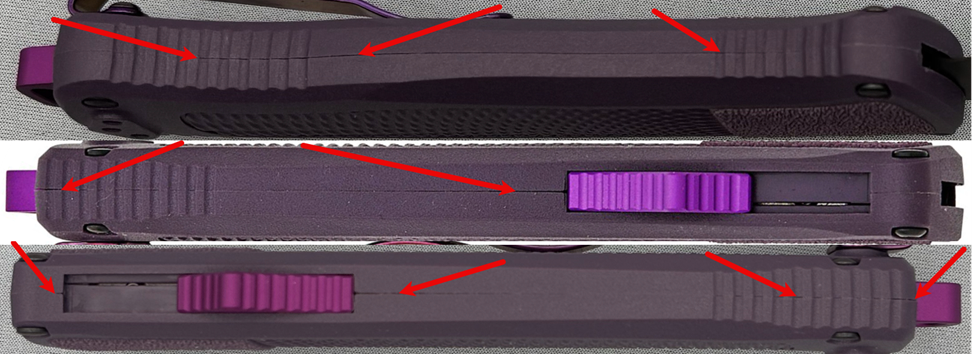
The top and bottom photos are mine, but the middle photo comes courtesy of Benchmade themselves, and even their example is just as crappily assembled as the knife I am reviewing.
Handle Dimensions
There are only a few numbers to cover, so let’s get to it. The handle length was measured at 124.96 mm / 4.92″, the handle height came in at 29.92 mm / 1.18″, and the handle thickness is 12.65 mm / 0.498″. The blade-to-handle ratio comes out to 0.71.
Hardware
There’s not a whole lot to talk about in this section, but let’s go for it. The dark purple Shootout pocket clip is a stamped steel, surface-mounted, ambidextrous, deep-carry clip. There isn’t a flat spot on the heavily-textured Grivory handle to protect the fabric of your nice dress pants from being shredded (it would have to be there on both sides, you know, for the lefty pants). The clip’s retention is moderately soft, which may help with pants shredding, but may also allow the knife to fall off in a moment of chaos (or not). You can’t have your cake and a smoky, peaty Islay Scotch, too. Aw, screw the cake; gimme the Islay.
The best feature of the purple clip is … can you guess? The color purple! Benchmade calls it their purple PVD clip. If you thought of PVD finishes as only matte (as in the Shootout’s blade finish), then you were today years old when you learned this! It’s a beautiful color finish. The clip is 58.27 mm / 2.29″ in length, which means its clip length-to-handle percentage is 46.6%, below that pesky 50% length that many people dislike. As usual, the clip features the Benchmade butterfly logo just below the waistline cutouts for the clip screws. It has only a shallow rise from the contact patch, which means that due to that and the shorter clip-length ratio, it won’t likely be a problematic palm poker.
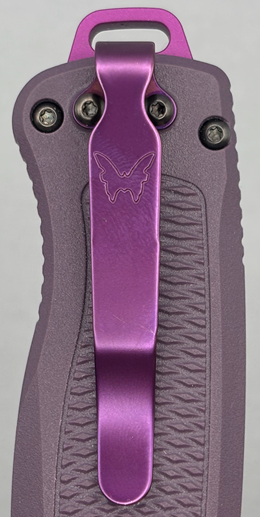
There are only 4 fasteners, one in each corner of the handle, plus 2 more for the pocket clip retention, and they are all black-coated, button-top, T6 screws on the clip side. Given the very weak magnetic response to my magnet test, they are likely made from 300-series stainless steel. You know, the good stuff. The show side fasteners are very strongly magnetic, round top, Chicago-style, steel binding post screws.
Ergonomics
The handle, despite the very modest Grivory flex, is pretty comfortable. In fact, that ever-so-slight Grivory handle flex might add a slight benefit to the grip ergos, as it seems to slightly mold to the hand better than, say, flat and super-thin scales on folding knives. The Shootout OTF handle is both slightly contoured, has nicely beveled outside edges, and the grippiness of the Grivory-molded texture does the job as intended. The Grivory material makes it feel cheap to the fingertips, but in a full hand grasp, it’s not bad at all. There are ersatz hand guards at the front of the molded Grivory handle that will help (a little bit) in protecting your manos from sliding up onto that sharp blade.
As mentioned earlier, the jimped OTF spine slide button uses fairly firm springs to both open and close the blade. Many higher-end OTFs use far firmer springs, so this Goldilocks setup is a nice balance between not too tight and not too soft, providing both comfort and security.
Weight
The Shootout is a very light knife, especially given it has a near 3.5” blade. The weight per my scale came in at 81.78 g / 2.89 oz. As the blade length is 88.14 mm / 3.47″, this gives the knife a weight-to-blade-length ratio of 0.93. Pay attention when this knife is in your pocket. With that pocket clip’s semi-soft retention and it being so lightweight, you may not notice if it falls out!
Original Packaging
This is a typical Black class box. The box is a heavy, rigid, paperboard, full telescope box with a dense, black, medium-soft, large closed-cell foam lining pressed into the lower. The box contains the knife, enclosed in a black, satin drawstring bag and includes a rectangular-folded Use & Care sheet. Basic Benchmade.
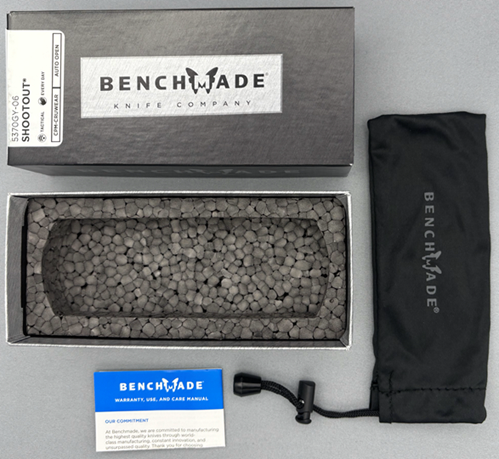
Knife Karen Nitpicks
I have some issues to discuss with Benchmade management here. In fact, I’m on fire about this!
- The blade has genuine problems. This “premium” knife’s edge bevel angles are not sharpened evenly. It’s not even close. The edge bevel on the show side was ground to a shallow 24°, but the clip side was ground to a steeper 20°, a 4° difference that you can see! The blade has a compound, tanto grind, and even that second grind wasn’t symmetrical. The tanto show side edge bevel came in at 29° whereas the clip side edge bevel was at 27°. Hey Benchmade! Aren’t you a premium knife manufacturer? Aren’t knives from premium knifemakers supposed to have symmetrically ground blades? What is this mess?
- Unfortunately, it gets even worse for the blade. The blade’s swedge grinds are not even the same length on the blade! Unbelievable! I measured the show side swedge length to be 53.22 mm / 2.095″, whereas the clip side swedge length came in at 50.21 mm / 1.977″. Benchmade, are you letting your high school interns into the machine shop again? Seriously, dudes, this is really crappy bladesmithing. For the price you charge, this is unacceptable.
- Benchmade claims that their blade was hardened to 64HRc +/- 1 point (aka 63-65). I have no way to test this, but I seriously doubt this is the case. I looked through the results of a dozen professionally-hardness-tested Cru-Wear blades (details above), all from Spyderco, and the average hardness of those blades was 62.24 HRc. Larrin Thomas spoke of this steel composition and showed that the toughness ratings were optimized at a middling hardness rating of 61.8 HRc. However, toughness ratings dropped in half to a poor level rating when that steel is hardened to 64 HRc. If Benchmade did harden their CPM Cru-Wear blade to their claimed hardness, they likely ruined the performance of the blade.
- Now let’s talk about the handle. Benchmade turns to Grivory handle materials (a type of fiberglass reinforced nylon, aka FRN) when they need to go budget (budget for Benchmade, anyway). But as anyone who has held a Grivory-laden Benchmade knows, this material just feels so cheap. Frankly, it looks cheap as well.
- Unfortunately, it gets even worse for the handle! There are noticeable handle seam fitment issues. Let me be clear. I am saying that Benchmade did not get the 2-piece handle seams to line up! I took photos of the gaps and included them above. Heck, even Benchmade’s own promotional photography includes a handle with seam gaps! This is atrocious, especially for the price!
- So let’s talk about the price. Suffice it to say that Benchmade has once again released a knife that is priced far higher than other, similarly (or better) configured knives from other American manufacturers (not imported from China). And given the glaring fit and finish problems of both the blade and the handle, this pricing is indefensible. Benchmade, you are ruining your reputation among knife enthusiasts with these overpriced, poor value products. Is this your intention? I’d assume not, but this is what you are accomplishing with such shoddy work at such high prices. Where is the value?
Price
Let’s dig into the prices issue. The MSRP (manufacturer’s suggested retail price) for the Shootout, the second lowest-end OTF in the Benchmade line, is $375. Benchmade typically allows their dealers to offer a 10% discount, but that’s it – nothing deeper than that (unless you go to a brick-and-mortar store and they offer a non-advertised, in-store discount). So the online discounted MAP (Minimum Advertised Price) should be $337.50 – if you can find it. All but 1 of the online retailers I found for the purple Shootout were offering NO discount, charging instead the full MSRP of $375. That truly sucks, especially when there are such product quality problems.
Professional Shopper Tip: If you search for an online retailer who carries the knife but sells more than just knives, on occasion such stores may offer a store-wide discount coupon for more than 10% off, so perhaps you can do better than $337.50. I found an online retailer during the December holidays in 2023 who had the Benchmade Mini Adamas with carbon fiber and MagnaCut in stock. They had a store-wide discount coupon of 20%! That was cool, although I still think I overpaid a bit. But it can pay to shop around.
That all said, for $42 more than MAP (or a mere $4 over MSRP), you can instead pay $379 for an American-made, double-action, Microtech Ultratech Zero Blade Play (ZBP) OTF knife that has a 3.5” M390MK blade and an aluminum handle (not the crappy Grivory that Benchmade doesn’t even bother to fit together very well). And of course, the ZBP blade management mechanism ensures the Microtech blade doesn’t wiggle up and down, left and right, or in and out when deployed, all of which the Benchmade Shootout blade does quite readily.

If zero blade play doesn’t matter to you, then take a look at the highly regarded, American-made, double-action Kershaw Livewire. It comes with a 3.3” CPM MagnaCut blade and an aluminum handle, and costs a mere $216, a full $159 less than the Shootout MSRP.

There’s really no value advantage in buying this Benchmade.
Verdict
The Benchmade Shootout Seasonal Deep Purple OTF is simply a mediocre knife with both positive and surprisingly disappointing features. Let’s start with the positive features.
Positives
The Blade Goodness
- The blade is very thin and slicey. It’ll be a fine slicer, although whether or not that property is taken advantage of by the user is unknown. Usually people who use fine slicers typically do so in the kitchen, although cutting the odd sisal rope, opening paper envelopes and slicing plastic tape on sealed cardboard boxes does come to mind. But I don’t see an OTF being used for culinary tasks. Who wants rotting, stinky foodstuffs gumming up the insides of their OTF?
- The out-of-the-box sharpness was very good. Given my previous experience with my Benchmade Mini Adamas in MagnaCut, which was not very sharp when new, this was very positive experience.
- The non-stainless, CPM Cru-Wear steel’s vulnerability to rust is resolved by the gray PVD coating. If you’re going to buy a knife with a non-stainless-steel blade, you either need to plan to regularly keep it oiled or buy one that has a permanent, durable coating added to it. PVD is used here, and while not a durable and protective as DLC, PVD will hold up for a reasonable amount of time, and will last even longer if you don’t cut anything abrasive – like paper, cardboard, and whatnot.
The Handle Goodness
- The color of this seasonal release of the Shootout may be its best feature. I love it! I am especially a fan of the shiny purple coating of the steel pocket clip!
- The handle has a grippy texture and a hand-filling size for firmly grasping the knife. Yes, the handle is pretty ergonomic and grippy. The thumb spot is grippy like 40-grit sandpaper, and the remainder of the handle body sports a grippy surface made of a classic sunburst Guilloche pattern, has nicely chamfered edges, and the slight Grivory flex in the handle almost helps it contour to your hand. It doesn’t flex like the flat-handled folding pocketknives that use cartridge liners with Grivory scales, but it does still flex a tiny bit. Press on the handle while looking at it from the side. Easy peasy Benchmade squeezy.
- The OTF action is a good balance of firm and comfortable. It works, and that’s good.

Negatives
Now let’s address the disappointments with the Benchmade Shootout.
The Blade Disappointments
- The edge bevels are not even. It’s easily visible by the naked eye – the show side has a shallower edge bevel angle than the clip side. In addition, the tanto second edge bevels are not symmetrical, either, and they do not match the angles of the main edge bevels.
- The swedge is not symmetrical between the sides. The lengths of the swedges are not the same, and their position along the spine are slightly different. I think these knives must have been made when the shop side of the house was doing Bring your Child to Work Day. Seriously.
- Benchmade’s claimed Rockwell hardness of 63-65, if accurate, is simply too high. Per the research of Larrin Thomas on toughness of blade steels, he found that for Z-Wear, a steel that is the compositional equivalent to CPM Cru-Wear, the optimum level of toughness was achieved when the blade was heat treated to the hardness of just under 62 HRc. But when the same steel was heat treated to HRc 64, the level of toughness was cut in half, rendering the blade far more brittle. Not good.
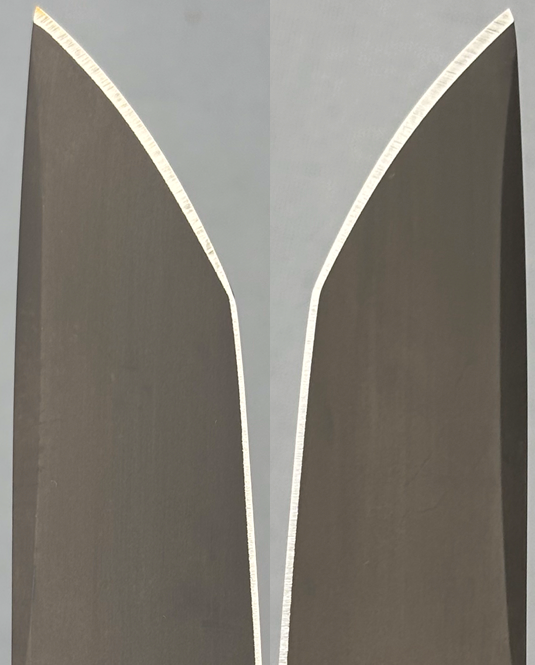
The Handle Disappointments
- Grivory just looks and feels like cheap plastic. What can you say? It looks cheap and feels cheap, not as inexpensive, but as inferior, although inexpensive can be like a plastic toy as opposed to a robust, professional quality tool. And that cheapness confers negative quality perceptions upon the knife that uses it. But considering the issues noted in this Negatives section, it’s actually a fair assessment.
- There are notable gaps in the seams of the Grivory handle material. It’s really surprising how poorly the fit and finish work of the Grivory handles was done. These problems are a shocking revelation of the decline in the quality of Benchmade products.
After all the above, like most knives Benchmade releases today, the Shootout is way overpriced for the value it offers. The Shootout costs as much as the recently released, American-made Microtech Ultratech ZBP (Zero Blade Play) OTF series of knives, which in addition to having a significant upgrade in handle materials (aluminum vs Grivory), it has zero blade play! It’s so impressive that they put it in the name! The ZBP is an OTF whose blade doesn’t wiggle all about when deployed. It’s just a solid, confidence-inspiring knife that offers much better value for the money. But if it’s all about the money to you, but you still want a very good quality, American-made OTF, look no further than the Kershaw Livewire. For a price that’s at least $150 less than the Shootout, the Livewire offers a 3.3” MagnaCut blade and an aluminum handle, and it has a higher buyer rating than the Shootout. With available options like those above, as well as the significant manufacturing quality problems of the model I reviewed, quite frankly, the value of the Benchmade Shootout Out-The-Front pocketknife is at the back of the pack of OTFs on the market today.
Does the Shootout work? Sure. Did I like it? It was… interesting. Do I recommend it? Based on all the above, no. I believe if you want a new OTF, you can do better than the Benchmade Shootout. ![]()

